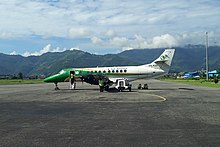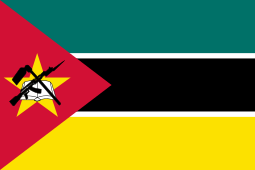British Aerospace Jetstream 41
The British Aerospace Jetstream 41 is a turboprop-powered feederliner and regional airliner, designed by British Aerospace as a stretched version of the popular Jetstream 31. Intended to compete directly with 30-seat aircraft like the Embraer Brasilia, Dornier 328 and Saab 340, the new design eventually accommodated 29 passengers in a two-by-one arrangement like the Jetstream 31. Eastern Airways of the UK is the biggest operator of Jetstream 41s in the world, with 14 in the fleet.
| Jetstream 41 | |
|---|---|
 | |
| Eastern Airways BAe Jetstream 41 | |
| Role | Regional airliner/Feederliner |
| National origin | United Kingdom |
| Manufacturer | British Aerospace |
| First flight | 25 September 1991 |
| Introduction | 25 November 1992 |
| Status | In service |
| Primary users | Eastern Airways South African Airlink Easyfly Yeti Airlines |
| Produced | 1992–1997 |
| Number built | 100 |
| Unit cost |
$6 million (1991) [1] |
| Developed from | British Aerospace Jetstream 31 |
Design and development
The Jetstream 41's stretch added 16 feet (4.88 m) to the fuselage, consisting of an 8-foot 3 in (2.51 m) plug forward of the wing and a 7 feet 9 inches (2.36 m) plug to the rear; the fuselage design was all new and did not contain any parts of the old fuselage. The new design demanded a wing with increased span, which also included reworked ailerons and flaps. The wing is also mounted below the fuselage, so that it did not carry through the cabin aisle, also allowing increased baggage capacity in the larger wing root fairings.[2]
The Allied Signal TPE331−14 engines deliver 1,500 shp (1,120 kW), (later 1,650 shp (1,232 kW)), and are mounted in nacelles with increased ground clearance. The flightdeck is improved with a modern EFIS setup, and a new windscreen arrangement.[2][3] The J41 was the first turboprop certified to both JAR25 and FAR25 standards.
Operational service

The J41 flew for the first time on 25 September 1991 and was certified on 23 November 1992 in Europe, and 9 April 1993 in the United States, with the first delivery, to Manx Airlines on 25 November 1992.[3] In January 1996, the J41 became part of the Aero International (Regional) (AI(R)), a marketing consortium consisting of ATR, Aérospatiale (of France), Alenia (of Italy), and British Aerospace. Sales initially were fairly strong, but in May 1997 BAe announced that it was terminating J41 production,[4] with 100 aircraft delivered.
Operators
As of July 2018, 51 aircraft remain in active commercial service.[5]
Civil operators

- Sky Express (1)

- Yeti Airlines (6)

- South African Airlink (8)

_at_Bristol_International_Airport.jpg)
- Eastern Airways (14)
![]()
- Contour Airlines (4)
Operated by Corporate Flight Management

- Proflight Zambia (3)
Other operators include:

- Royal Star Aviation (1)
- Air Republiq Airlines (1)
Former Civil operators
.svg.png)

- EasyFly (Colombia) (10)

- Hong Kong Government Flying Service – (2) for search-and-rescue.


- Agni Air (3)

- Eastern SkyJets (1)

- Trans States Airlines (25) – aircraft operated as American Connection, Delta Connection and Trans World Express providing passenger feed service on behalf of respective major air carrier partners American Airlines, Delta Air Lines and Trans World Airlines (TWA).[6]
- Atlantic Coast Airlines – aircraft operated as United Express providing passenger feed service on behalf of major air carrier partner United Airlines.[7]

- Delbitur (1)

- Venezolana (9)
Preservation
The prototype Jetstream 41 G-JMAC is preserved by the Speke Aerodrome Heritage Group (SAHG) on the former airside apron behind the Crowne Plaza Liverpool John Lennon Airport Hotel, which was the original terminal building of Liverpool Speke Airport.[8]
Accidents and incidents
- On 7 January 1994, United Express Flight 6291 crashed short of the runway at Port Columbus International Airport killing five people out of eight passengers and crew.[9]
- On 24 September 2009, Airlink Flight 8911 crashed in the suburb of Merebank in Durban, South Africa, shortly after takeoff from Durban International Airport. The crew of three and one person on the ground was injured.[10][11] The captain, Allister Freeman, died as a result of complications from his injuries on 7 October 2009.[12]
- On 24 September 2016, A Yeti Airlines flight registration 9N-AIB en route from Kathmandu to Bhairahawa overran the runway while landing at Gautam Buddha Airport. All 29 passengers and the crew of 3 were unhurt but the aircraft was damaged beyond repair.[13]
Specifications (Jetstream 41)
Data from Jane's All the World's Aircraft 1997-98,[14] Brassey's World Aircraft & Systems Directory 1996/97[3]
General characteristics
- Crew: 3 (2 Pilots + Flight Attendant)
- Capacity: 29 passengers
- Length: 63 ft 2 in (19.25 m)
- Wingspan: 60 ft 0 in (18.29 m)
- Height: 18 ft 10 in (5.74 m)
- Wing area: 350.8 sq ft (32.59 m2)
- Airfoil: root: NACA 63A418; tip: NACA 63A412[15]
- Empty weight: 14,272 lb (6,474 kg)
- Maximum zer0-fuel weight: 21,400 lb (9,707 kg)
- Max takeoff weight: 24,000 lb (10,886 kg)
- Maximum ramp weight: 24,100 lb (10,932 kg)
- Maximum landing weight: 23,300 lb (10,569 kg)
- Fuel capacity: 727 imp gal (873 US gal; 3,305 l) / 5,960 lb (2,703 kg) maximum
- Powerplant: 2 × Allied Signal TPE331-14GR/HR turboprop engines, 1,650 shp (1,230 kW) each (handed GR / HR)
- Propellers: 5-bladed McCauley, 9 ft 6 in (2.9 m) diameter (handed GR / HR) constant-speed feathering metal propellers
Performance
- Maximum speed: 295 kn (339 mph, 546 km/h) at 20,000 ft (6,096 m)
- Cruise speed: 295 kn (339 mph, 546 km/h) max at 20,000 ft (6,096 m)
- 260 kn (299 mph; 482 km/h) at 20,000 ft (6,096 m) economical cruise
- Never exceed speed: 315 kn (362 mph, 583 km/h) CAS sea level to 17,400 ft (5,304 m)
- M0.65 above 17,400 ft (5,304 m)
- Range: 774 nmi (891 mi, 1,433 km) with 29 pax + IFR reserves
- Service ceiling: 26,000 ft (7,900 m)
- Service ceiing on one engine: 15,000 ft (4,572 m)
- Rate of climb: 2,200 ft/min (11 m/s)
- Wing loading: 68.42 lb/sq ft (334.1 kg/m2)
- Power/mass: 0.1375 shp/lb (0.2260 kW/kg)
- Take-off run: 5,000 ft (1,524 m)
- Landing run: 4,200 ft (1,280 m)
Avionics
Honeywell avionics with four screen EFIS
See also
Related development
- Jetstream 31
Aircraft of comparable role, configuration and era
- Embraer EMB 120 Brasilia
- DHC-8 100/200
- Dornier 328
- Saab 340
- Shorts 360
References
- Flying Magazine, June 1991, P.30
- Swanborough 1991, p. 78.
- Taylor 1996, pp. 260–261.
- O'Toole 1997, p.4.
- "World Airline Census 2018". Flightglobal.com. Retrieved 27 August 2018.
- airliners.net, Trans States Airlines BAe J41 photos
- airliners.net, Atlantic Coast Airlines BAe J41 photos
- Taylor, Rob. "Welcome to the Jetstream Club." Archived 21 September 2008 at the Wayback Machine The Jetstream Club, 9 September 2008. Retrieved: 30 March 2010.
- "Accident description." aviation-safety.net. Retrieved: 30 March 2010.
- "Media Release: Accident= Airlink Flight Update No. 2 at 16h30." Archived 19 July 2011 at the Wayback Machine Airlink, 24 September 2009. Retrieved: 30 March 2010.
- "Crash plane declared emergency." IOL, 24 September 2009. Retrieved: 30 March 2010.
- "Media release 16 – Accident airlink flight update No. 15 – 07/10/09." saairlink.co.za,October 2009. Retrieved: 30 March 2010.
- Pathak, Anurup (24 September 2016). "Yeti Airlines 9N-AIB Escaped from an accident". Aviation Nepal. Retrieved 5 July 2017.
- Jackson, Paul, ed. (1997). Jane's All the World's Aircraft 1997-98 (88th ed.). Coulsdon, Surrey, United Kingdom: Jane's Information Group. pp. 532–534. ISBN 9780710615404.
- Lednicer, David. "The Incomplete Guide to Airfoil Usage". m-selig.ae.illinois.edu. Retrieved 16 April 2019.
Bibliography
- Lambert, Mark. Jane's All The World's Aircraft 1993–94. Coulsden, UK:Jane's Data Division, 1993. ISBN 0-7106-1066-1.
- O'Toole, Kevin. "Prestwick seeks new work after J41 closure". Flight International, 4–10 October 1997, p. 4.
- Swanborough, Gordon. "Jetstream Jubilee". Air International, August 1991, Vol 41 No 2, pp. 73–79. Stamford, UK:Key Publishing. ISSN 0306-5634.
- Taylor, Michael, ed. Brassey's World Aircraft & Systems Directory 1996/97. London: Brassey's, 1996. ISBN 978-1-85753-198-5.
- Wilson, Stewart. Airliners of the World. Fyshwick, Australia: Aerospace Publications Pty Ltd., 1999. ISBN 978-1-875671-44-1.
External links
| Wikimedia Commons has media related to Jetstream 41. |
- BAE Systems history
- Airliners.net BAE Jetstream 41
- "Growing a family". Flight International. 20 March 1991. pp. 28–41.